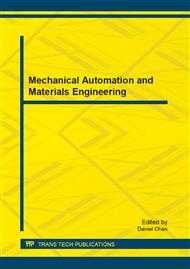[1]
F. Chen, H. Jiang, X. Bai and W. Zheng: J. Ind. Eng. Chem. Vol. 19 (2013), pp.450-457.
Google Scholar
[2]
D.A.Z. Wever, F. Picchioni and A.A. Broekhuis: Prog. Polym. Sci. Vol. 36 (2011), pp.1558-1628.
Google Scholar
[3]
B.Y. Jamaloei, K. Asghari and R. Kharrat: J. Pet. Sci. Eng., Vol. 90–91(2012), pp.48-55.
Google Scholar
[4]
M.T. Bao, Q.G. Chen, Y.M. Li and G.C. Jiang: J. Hazard. Mater. Vol. 184 (2010), pp.105-110.
Google Scholar
[5]
C.F. Han, D.P. Li, and X. M Wang: Chin. J. Appl. Environ. Biol. Vol. 11 (2005), pp.648-650. (Chinese).
Google Scholar
[6]
Q.X. Wen, Z.Q. Chen, Y. Zhao, H.C. Zhang and Y. J Feng: J. Hazard. Mater. Vol. 175 (2010), p.955–959.
Google Scholar
[7]
Y.L. Zhan, S.H. Guo, and G.X. Yan: Poly. Bull. Iss. 2 (2004), pp.70-75. (Chinese).
Google Scholar
[8]
A.S. Kuperman and J. Pharmacol: Exp. Ther. Vol. 123 (1958), pp.182-192.
Google Scholar
[9]
R.W. Tyl, and H.A. Friedman: Reprod. Toxicol. Vol. 17 (2003), pp.1-13.
Google Scholar
[10]
Y.H. She, L.G. Zhou, H.J. Liu, J.Z. Wang, F. Zhang, X.Q. Li, and H.Y. Zhang: Ecol. Sci. Vol. 24 (2005), pp.344-346. (Chinese).
Google Scholar
[11]
S. Magdaliniuk, J.C. Block, C. Leyval, J.Y. Bottero, G. Villemin and M. Babut: Water Sci. Technol. Vol. 31 (1995), pp.85-94.
DOI: 10.2166/wst.1995.0020
Google Scholar
[12]
N. Kunichika and K. Shinichi: J Ferment. Bioengin. Vol. 80 (1995), p.418–420.
Google Scholar
[13]
P.J. Holliman, J. A. Clark, J. C. Williamson, and D. L. Jones: Sci. Total Environ. Vol. 336(2005), pp.13-24.
Google Scholar
[14]
J.L. Kay-Shoemake, M.E. Watwood, R.E. Sojka and R.D. Lentz: Soil Boil. Biochem. Vol. 30(1998), pp.1647-1654.
DOI: 10.1016/s0038-0717(97)00251-4
Google Scholar
[15]
F. Huang, H.X. Fan, Z.H. Dong and L.M. Xu: Pet. Proc. Petrochem. Vol. 30 (1999), pp.33-36. (Chinese).
Google Scholar
[16]
M. T. Bao, K. J. Luo, X. L. Geng, H. F. Wang, S. X. Guo, and X. M. Li: Oilfield Chem. Vol. 24 (2007), pp.188-192. (Chinese).
Google Scholar
[17]
J.Q. Liu, M.T. Bao, H.F. Wang, S.X. Guo and X.M. Li: J. Southwest Pet. Univer. Vol. 29(2007), pp.110-113. (Chinese).
Google Scholar
[18]
Y. L. Yao, Z. M. Lv, H. Min, Z. H. Lv and H. P. Jiao: Bioresour. Technol. Vol. 100(2009), pp.2762-2769.
Google Scholar


